The Interactions between Polyphenols and Microorganisms, Especially Gut Microbiota
- PMID: 33525629
- PMCID: PMC7911950
- DOI: 10.3390/antiox10020188
The Interactions between Polyphenols and Microorganisms, Especially Gut Microbiota
Abstract
This review presents the comprehensive knowledge about the bidirectional relationship between polyphenols and the gut microbiome. The first part is related to polyphenols' impacts on various microorganisms, especially bacteria, and their influence on intestinal pathogens. The research data on the mechanisms of polyphenol action were collected together and organized. The impact of various polyphenols groups on intestinal bacteria both on the whole "microbiota" and on particular species, including probiotics, are presented. Moreover, the impact of polyphenols present in food (bound to the matrix) was compared with the purified polyphenols (such as in dietary supplements) as well as polyphenols in the form of derivatives (such as glycosides) with those in the form of aglycones. The second part of the paper discusses in detail the mechanisms (pathways) and the role of bacterial biotransformation of the most important groups of polyphenols, including the production of bioactive metabolites with a significant impact on the human organism (both positive and negative).
Keywords: bioactive compounds; biotransformation; catabolism; diversity; health; inhibition; intestinal microbiota; metabolism; metabolites.
Conflict of interest statement
The authors declare no conflict of interest.
Figures
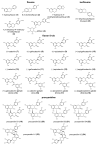





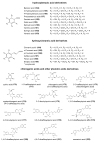




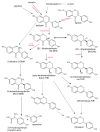



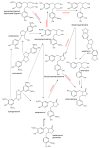
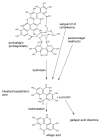
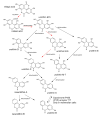



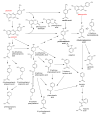
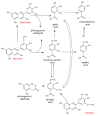

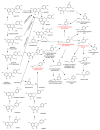
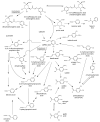

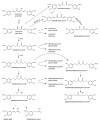
Similar articles
-
Interaction of dietary compounds, especially polyphenols, with the intestinal microbiota: a review.Eur J Nutr. 2015 Apr;54(3):325-41. doi: 10.1007/s00394-015-0852-y. Epub 2015 Feb 12. Eur J Nutr. 2015. PMID: 25672526 Free PMC article. Review.
-
Dietary polyphenol impact on gut health and microbiota.Crit Rev Food Sci Nutr. 2021;61(4):690-711. doi: 10.1080/10408398.2020.1744512. Epub 2020 Mar 25. Crit Rev Food Sci Nutr. 2021. PMID: 32208932 Review.
-
Dietary polyphenol and microbiota interactions in the context of prostate health.Ann N Y Acad Sci. 2022 Feb;1508(1):54-77. doi: 10.1111/nyas.14701. Epub 2021 Oct 11. Ann N Y Acad Sci. 2022. PMID: 34636052 Review.
-
Interactions of gut microbiota with dietary polyphenols and consequences to human health.Curr Opin Clin Nutr Metab Care. 2016 Nov;19(6):471-476. doi: 10.1097/MCO.0000000000000314. Curr Opin Clin Nutr Metab Care. 2016. PMID: 27490306 Review.
-
Roles of the Polyphenol-Gut Microbiota Interaction in Alleviating Colitis and Preventing Colitis-Associated Colorectal Cancer.Adv Nutr. 2021 Mar 31;12(2):546-565. doi: 10.1093/advances/nmaa104. Adv Nutr. 2021. PMID: 32905583 Free PMC article. Review.
Cited by
-
Polyphenols as Drivers of a Homeostatic Gut Microecology and Immuno-Metabolic Traits of Akkermansia muciniphila: From Mouse to Man.Int J Mol Sci. 2022 Dec 20;24(1):45. doi: 10.3390/ijms24010045. Int J Mol Sci. 2022. PMID: 36613488 Free PMC article. Review.
-
Shotgun Metagenomic Sequencing Revealed the Prebiotic Potential of a Fruit Juice Drink with Fermentable Fibres in Healthy Humans.Foods. 2023 Jun 25;12(13):2480. doi: 10.3390/foods12132480. Foods. 2023. PMID: 37444219 Free PMC article.
-
Recent Prospects of Carbonaceous Nanomaterials-Based Laccase Biosensor for Electrochemical Detection of Phenolic Compounds.Biosensors (Basel). 2023 Feb 22;13(3):305. doi: 10.3390/bios13030305. Biosensors (Basel). 2023. PMID: 36979517 Free PMC article. Review.
-
Production of Polyhydroxybutyrate by Genetically Modified Pseudomonas sp. phDV1: A Comparative Study of Utilizing Wine Industry Waste as a Carbon Source.Microorganisms. 2023 Jun 15;11(6):1592. doi: 10.3390/microorganisms11061592. Microorganisms. 2023. PMID: 37375094 Free PMC article.
-
Encapsulation of Olea europaea Leaf Polyphenols in Liposomes: A Study on Their Antimicrobial Activity to Turn a Byproduct into a Tool to Treat Bacterial Infection.ACS Appl Mater Interfaces. 2024 Dec 18;16(50):68850-68863. doi: 10.1021/acsami.4c13302. Epub 2024 Dec 4. ACS Appl Mater Interfaces. 2024. PMID: 39631768 Free PMC article.
References
Publication types
Grants and funding
LinkOut - more resources
Full Text Sources
Other Literature Sources
Molecular Biology Databases

